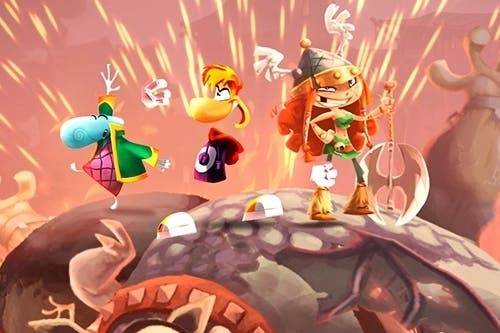Digital Foundry vs. the Rayman Legends demo
Analysis of one of the Wii U's most promising upcoming exclusives.
One of the most genuinely exciting playable demos released in recent times, Rayman Legends on Wii U combines beautiful artwork, animation and audio with some innovative GamePad integration - and it all runs at native 1080p with a nigh-on flawless 60 frames per second update. Exclusive to the new Nintendo console, it's an interesting example of how third parties can put the hardware through its paces without having to worry about cross-platform conformity. The GamePad features aren't optional extras but instead form an integral part of the whole proposition: it's a release that simply wouldn't be the same on any other home console.
There's a fair few points to discuss from a technical perspective too. Rayman Origins demonstrated spectacularly that 2D artwork can still look stunning, and that the reduced processing power required opens the door for running a visually arresting game at full 1080p.
The 2D visuals also proved immensely scalable, with excellent renditions of the game across a range of platforms including Wii and Vita. Notably, the game still manages to run at the full 60 frames per second even in native 2880x1800 resolution on the Retina Macbook Pro. Rayman Legends on Wii U is notable in that it retains the extreme resolution and frame-rate capabilities of the engine, but adds 3D elements to the mix.
"Rayman Legends combines wonderful 2D art with accomplished 3D elements and superb production values all-round."
The Teensies in Trouble level - one of three in the 521MB downloadable sampler - showcases this rather well, especially in the opening sequence. The camera moves "in" and "out" of the 2D world, producing some spectacular effects, giving real depth to the level - a blurring depth-of-field effect on foreground 2D artwork adds to the effectiveness of the effect. 2D characters are scaled alongside the environments, but we also see 3D objects overlaid too - a new addition to the Rayman engine. These elements are relatively low poly, but they are very well animated and sympathetically lit, fitting in well with the 2D elements. Although we don't see it in the levels showcased here, previous footage also seems to have shown a 3D lightmap dynamically overlaid onto the environment.
To get a better idea of how everything integrates into the game's overall aesthetic, we've prepared a 1080p Rayman Legends screenshot gallery. Everything is grabbed in-game from the demo and is generated in real-time.
We've also prepared a couple of performance analysis videos, again captured in full HD, and encompassing the entirety of the demo's content. The analysis itself is somewhat one-note, however. In contrast to some of the video circulating during E3 which revealed some performance dips, we see absolutely no cause for concern here - Rayman Legends plays out almost entirely at 1080p60 with just one unnoticeable frame-rate drop logged at the end of one of the levels.
"This is shaping up to be a superb platform exclusive for the Wii U. GamePad integration isn't an afterthought - it's a core component of the game."
But running straight captures of the game doesn't really make sense for the Teensies in Trouble level, where the GamePad takes centre-stage - you're literally only seeing half of the action, as in single-player mode, the character on-screen is controlled via CPU while the player takes control of secondary character Murphy.
Here, interactions with the environment are dictated entirely by touch-screen and motion-sensor movements - gadgets on-screen are touched and manipulated by tilting the controller, while ropes are cut and objects with handles are shunted around the screen. Enemies are dispatched either by tickling them into submission or else tapping them into submission. What's interesting here from a technical perspective is that while the main screen visuals are mirrored on both HDTV and GamePad, unique elements are added for each display, unique to each character.
Elsewhere, the demo offers up a more standard Rayman Origins-style gameplay experience on the Toad Story stage, while the last episode in the sampler - Castle Rock - is a fun, if somewhat linear, merging of a musical number with platform gameplay. It sounds like a really bad idea, but as you'll see in the video at the foot of the page it actually works rather well.
Overall, we came away impressed by this demo - it looks beautiful, the production values are superb, it plays to the strengths of the host hardware, and it showcases a range of lovely ideas. The only real question we have is whether the Ubisoft development team can sustain that irresistible momentum across an entire game. We'll find out closer to Rayman Legends' release date in March 2013.



